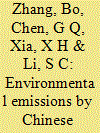| Srl | Item |
| 1 |
ID:
113460


|
|
|
|
|
| Publication |
2012.
|
| Summary/Abstract |
Based on chemical exergy as an objective measure for the chemical deviation between the emission and the environment, a unifying assessment is carried out for major environmental emissions covering COD, ammonia nitrogen, SO2, soot, dust, NOx and solid waste by Chinese industry over 1997-2006, with emphasis on the sectoral and regional levels in 2006. Of the total emission in exergy up to 274.1 PJ in 2006, 67.7% is estimated from waste gases, 29.9% from waste water and 2.4% from solid waste. Five of 40 sectors and 12 of 30 regions are responsible for 72.7% and 65.5% of the total emission, respectively. SO2 is the leading emission type in 9 sectors and 25 regions, and COD in another 28 sectors and 5 regions. Some pollution-intensive sectors such as Production and Distribution of Electric Power and Heat Power and Manufacture of Paper and Paper Products, and western and inland regions such as Guangxi and Ningxia with high emission intensities are identified. By clustering and disjoint principal component analysis with intensities of emissions and fuel coal use as variables, three principal components are extracted, and four statistically significant clusters are pinpointed in the sectoral and regional analysis. Corresponding policy-making implications are addressed.
|
|
|
|
|
|
|
|
|
|
|
|
|
|
|
|
| 2 |
ID:
179737


|
|
|
|
|
| Summary/Abstract |
Carbon capture, utilization and storage (CCUS) represents a set of technologies essential to meeting ambitious mid-to late-century decarbonization goals. Yet deployment of CCUS has been slow, with fewer than 20 large-scale facilities operating worldwide in 2019. We estimate the total and marginal cost of constructing and operating new CCUS facilities and associated infrastructure to reduce carbon dioxide (CO2) emissions from current and planned industrial facilities on the Texas and Louisiana Gulf Coast. We compare these cost estimates to scheduled CCUS tax incentives through 2026 under section 45Q of the U.S. Internal Revenue Code to quantify cost-effective emissions abatement. Our analysis measures the cost-reducing potential of economies of scale in regional CO2 pipeline networks. We also compare CCUS costs to one measure of the benefits of carbon capture, the social cost of carbon. Results suggest that U.S. federal tax incentives currently in place through 2026 could justify between 3.3 million and 77.6 million tons of annual CCUS in the Gulf region, depending on the choice of storage technology and the degree of pipeline network coordination. Finally, we highlight several potential policy barriers that may explain low adoption of CCUS in the Gulf Region and elsewhere.
|
|
|
|
|
|
|
|
|
|
|
|
|
|
|
|